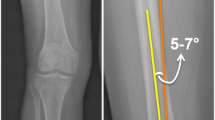Abstract
Aim
Our aim was to determine the variation in valgus correction angle and the influence of individualised distal femoral cut on femoral component placement and limb alignment during total knee replacement (TKR) in knees with varus deformity.
Materials and methods
The study was done prospectively in two stages. In the first stage, the valgus correction angle (VCA) was calculated in long-limb radiographs of 227 patients and correlated with pre-operative parameters of femoral bowing, neck-shaft angle and hip-knee-ankle angle. In the second part comprising of 240 knees with varus deformity, 140 (group 1) had the distal femoral cut individualised according to the calculated VCA, while the remaining 100 knees (group 1) were operated with a fixed distal femoral cut of 5°. The outcome of surgery was studied by grouping the knees as varus <10°, 10–15° and >15°.
Results
Of the 227 limbs analysed in stage I, 70 knees (31 %) had a VCA angle outside 5–7°. Coronal bowing (p < 0.001), neck-shaft angle (p < 0.001) and preoperative deformity (p < 0.001) significantly influenced VCA. Results of the second phase of the study showed a significant improvement in both femoral component placement and postoperative alignment when VCA was individualised in the groups of knees with varus 10–15° (p 0.002) and varus >15° (p 0.002).
Conclusion
Valgus correction angle is highly variable and is influenced by femoral bowing, neck-shaft angle and pre-operative deformity. Individualisation of VCA is preferable in patients with moderate and severe varus deformity.
Level of evidence
Level 2.






Similar content being viewed by others
References
Jeffery RS, Morris RW, Denham RA (1991) Coronal alignment after total knee replacement. J Bone Joint Surg (Br) 73:709–714
Sikorski JM (2008) Alignment in total knee replacement. J Bone Joint Surg (Br) 90:1121–7
Ritter MA, Faris PM, Keating EM, Meding JB (1994) Postoperative alignment of total knee replacement. Its effect on survival. Clin Orthop Relat Res 153:6
Kharwadkar N, Kent RE, Sharara KH, Naique S (2006) 5 degrees to 6 degrees of distal femoral cut for uncomplicated primary total knee arthroplasty: is it safe? Knee 13:57–60
Yoshioka Y, Siu D, Cooke TD (1987) The anatomy and functional axes of the femur. J Bone Joint Surg Am 69:873–880
Hsu RW, Himeno S, Coventry MB, Chao EY (1990) Normal axial alignment of the lower extremity and load-bearing distribution at the knee. Clin Orthop Relat Res:215–227
Howell SM, Kuznik K, Hull ML, Siston RA (2010) Longitudinal shapes of the tibia and femur are unrelated and variable. Clin Orthop Relat Res 468:1142–1148
Tang WM, Zhu YH, Chiu KY (2000) Axial alignment of the lower extremity in Chinese adults. J Bone Joint Surg Am 82-A:1603–1608
Nagamine R, Miura H, Bravo CV, Urabe K, Matsuda S, Miyanishi K et al (2000) Anatomic variations should be considered in total knee arthroplasty. J Orthop Sci 5:232–237
Mullaji AB, Marawar SV, Mittal VA (2009) Comparison of coronal plane axial femoral relationships in Asian patients with varus osteoarthritic knees and healthy knees. J Arthroplasty 24:861–867
Bardakos N, Cil A, Thompson B, Stocks G (2007) Mechanical axis cannot be restored in total knee arthroplasty with a fixed valgus resection angle: a radiographic study. J Arthroplasty 22:85–89
Angela DH, Martin S (2014) A comparison of variable angle versus fixed angle distal femoral resection in primary total knee arthroplasty. J Arthroplast 29:1133–1137
Hetaimish BM, Khan MM, Simunovic N, Al-Harbi HH, Bhandari M, Zalzal PK (2012) Meta-analysis of navigation vs conventional total knee arthroplasty. J Arthroplasty 27:1177–1182
Huang TW, Hsu WH, Peng KT, Hsu RW (2011) Total knee replacement in patients with significant femoral bowing in the coronal plane: a comparison of conventional and computer-assisted surgery in an Asian population. J Bone Joint Surg (Br) 93:345–350
Mullaji AB, Shetty GM, Kanna R, Vadapalli RC (2013) The influence of preoperative deformity on valgus correction angle: an analysis of 503 total knee arthroplasties. J Arthroplasty 28(1):20–27
Howell SM, Papadopoulos S, Kuznik K, Ghaly LR, Hull ML (2015) Does varus alignment adversely affect implant survival and function six years after kinematically aligned total knee arthroplasty? Int Orthop 39(11):2117–2124. doi:10.1007/s00264-015-2743-5
Sparmann M, Wolke B, Czupalla H, Banzer D, Zink A (2003) Positioning of total knee arthroplasty with and without navigation support. A prospective, randomised study. J Bone Joint Surg (Br) 85:830–835
Bauwens K, Matthes G, Wich M, Gebhard F, Hanson B, Ekkernkamp A et al (2007) Navigated total knee replacement. A meta-analysis. J Bone Joint Surg Am 89:261–269
Catani F, Biasca N, Ensini A, Leardini A, Bianchi L, Digennaro V et al (2008) Alignment deviation between bone resection and final implant positioning in computer-navigated total knee arthroplasty. J Bone Joint Surg Am 90:765–771
Del Gaizo DJ, Della Valle CJ (2011) Instability in primary total knee arthroplasty. Orthopedics 34:e519–e521
Forster-Horvath C, Kremo V, Müller-Gerbl M, Nowakowski AM (2015) Using the anatomical tibial axis for total knee arthroplasty alignment may lead to an internal rotation error. Int Orthop 39(12):2347–2353. doi:10.1007/s00264-015-2858-8
Kim SM, Kim KW, Cha SM, Han KY (2015) Proximal tibial resection in varus-deformed tibiae during total knee arthroplasty: an in vitro study using sawbone model. Int Orthop 39(3):429–434. doi:10.1007/s00264-014-2485-9
Huang AB, Wang HJ, Yu JK, Yang B, Ma D, Zhang JY (2015) Optimal patellar alignment with minimally invasive approaches in total knee arthroplasty after a minimum five year follow-up. Int Orthop. 2015
Mullaji AB, Ed FRCS, Orth MC, Orth MS, Shetty GM, Orth MS (2013) Computer-assisted sliding medial condylar osteotomy to achieve Gap balance in varus knees during TKA. Clin Orthop Relat Res 471:1484–1491. doi:10.1007/s11999-012-2773-x
Author information
Authors and Affiliations
Corresponding author
Rights and permissions
About this article
Cite this article
Palanisami, D., Iyyampillai, G., Shanmugam, S. et al. Individualised distal femoral cut improves femoral component placement and limb alignment during total knee replacement in knees with moderate and severe varus deformity. International Orthopaedics (SICOT) 40, 2049–2054 (2016). https://doi.org/10.1007/s00264-016-3123-5
Received:
Accepted:
Published:
Issue Date:
DOI: https://doi.org/10.1007/s00264-016-3123-5




